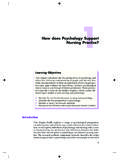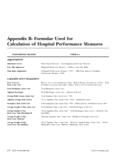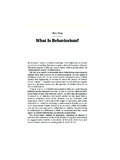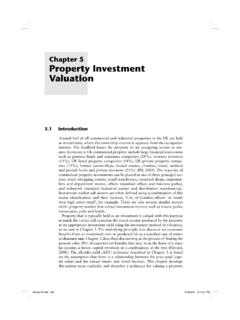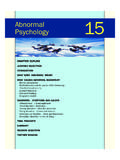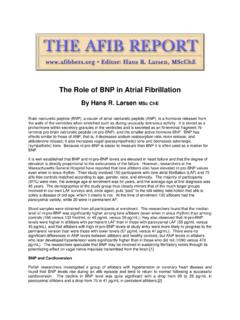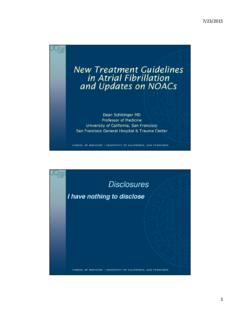Transcription of Pacemaker Timing Cycles 6 - Wiley-Blackwell
1 265 Understanding various pacing modes and paced electrocardiograms (ECGs)requires a thorough understanding of Pacemaker Timing Cycles . Pacemakertiming Cycles include all potential variations of a single complete pacing cycle the time from paced ventricular beat to paced ventricular beat;the time frompaced ventricular beat to an intrinsic ventricular beat, whether it is a conductedR wave or a premature ventricular contraction (PVC); the time from pacedatrial beat to paced atrial beat; the time from intrinsic atrial beat to paced atrialbeat; the time from intrinsic ventricular beat to paced ventricular beat; and soforth. These Cycles include events sensed, events paced, and periods when thesensing circuit or circuits are refractory. Each portion of the Pacemaker timingcycle should be considered in milliseconds and not in pulses per minute (ppm).Although thinking of the patient s pacing rate in paced beats per minute maybe easier, portions of the Timing cycle are too brief to consider in any unit of the relation between elements of the paced ECG enhancesunderstanding of Pacemaker rhythms.
2 Although multiple unknown factors mayaffect a native rhythm, each Timing circuit of a Pacemaker can function in onlyone of two states. A given timer can proceed until it completes its cycle ; com-pletion results in either the release of a pacing stimulus or the initiation ofanother Timing cycle . Alternatively, a given timer can be reset, at which pointit starts the Timing period make this chapter more readable and to facilitate clarity, a series ofabbreviations is used to designate native and paced events and portions of thetiming cycle . These abbreviations are listed in Box P indicates native atrialdepolarization, A an atrial paced event, R native ventricular depolarization, andV a ventricular paced event. I represents an interval. From this,PR refers to anative complex that completely inhibits the Pacemaker on both the atrial andthe ventricular channels.
3 AV refers to pacing sequentially in both the atrium andthe ventricle. If an atrial paced complex is followed by native ventricular depo-larization that inhibits the ventricular output of the Pacemaker , the designationis AR. If a native atrial complex is followed by a paced ventricular depolariza-6 Pacemaker Timing CyclesDavid L. Hayes and Paul A. LevineICD06 12/17/04 06:16 PM Page 265tion, P-synchronous pacing, the designation is PV. Because the Pacemaker timingcycle in dual-chamber pacing has more portions to consider than single-chamber pacing, more discussion is devoted to understanding dual-chambertiming Cycles , specifically those of universal (DDD) pacing programmable features may affect device behavior (Box ).These are discussed throughout the NOMENCLATUREA three-letter code describing the basic function of the various pacing systemswas first proposed in 1974 by a combined task force from the American HeartAssociation and the American College of Cardiology.
4 Since then, the code hasbeen updated is a generic code and, as such, does not describespecific or unique functional characteristics of each device. The code has first position reflects the chamber or chambers in which stimulationoccurs. A refers to the atrium, V indicates the ventricle, and D means dualchamber, or both atrium and second position refers to the chamber or chambers in which sensingoccurs. The letter designators are the same as those for the first position. Man-CARDIAC PACING AND ICDS266 Box Abbreviations for Native and Paced Events and Portions of the Timing CyclePNative atrial depolarizationAAtrial paced eventRNative ventricular depolarizationVVentricular paced eventIIntervalAVSequential pacing in the atrium and ventricleAVIP rogrammed atrioventricular pacing intervalARAtrial paced event followed by intrinsic ventricular depolarizationARPA trial refractory periodPVNative atrial depolarization followed by a paced ventricular event,P-synchronous pacingAEII nterval from a ventricular sensed or paced event to an atrial paced event,the VA intervalLRLL ower rate limitURLU pper rate limitMTRM aximum tracking rateMSRM aximum sensor ratePVARPP ostventricular atrial refractory periodRRAVDRate-responsive atrioventricular delayVAVentriculoatrial interval.
5 Interval from a sensed or paced ventricular event to an atrial paced eventVRPV entricular refractory periodICD06 12/17/04 06:16 PM Page 266ufacturers also use S in both the first and the second positions to indicate thatthe device is capable of pacing only a single cardiac chamber. Once the deviceis implanted and connected to a lead in either the atrium or the ventricle, Sshould be changed to either A or V in the clinical record to reflect the chamberin which pacing and sensing are third position refers to the mode of sensing, or how the pacemakerresponds to a sensed event. An I indicates that a sensed event inhibits the outputpulse and causes the Pacemaker to recycle for one or more Timing Cycles . Tmeans that an output pulse is triggered in response to a sensed event. D, in amanner similar to that in the first two positions, means that there are dual modesof response.
6 This designation is restricted to dual-chamber systems. An eventsensed in the atrium inhibits atrial output but triggers ventricular output. Unlikethe single-chamber triggered mode, in which an output pulse is triggered imme-diately on sensing, a delay occurs between the sensed atrial event and the trig-gered ventricular output to mimic the normal PR interval. If a native ventricularsignal or R wave is sensed, it inhibits ventricular output and possibly even atrialoutput, depending on where sensing Timing CYCLES267 Box Features That May Affect Device Behavior*Intrinsic rate slowerthan programmed base rateHysteresisSleep or rest rateSpecial algorithms (+PVARP on PVC)Base rate (AV, AR) higherthan programmed base rateSensor drivenRate smoothingMode-switching response rateSpecial algorithms (+PVARP on PVC)Intrinsic AV conduction interval (PR, AR) longerthan programmed paced or sensedAV IAV or PV hysteresisSinus rate with intact AV conduction exceeding MTRP aced or sensed AVI shorterthan programmed paced or sensed AVIRate-responsive AV delayNegative AV or PV hysteresisSafety pacingNCAP (noncompetitive atrial pacing)Auto-threshold testLoss of atrial tracking (DDD mode)Automatic mode switchMSR >MTR* Not necessarily continuously.
7 The effect can be on single Cycles or during a brief 12/17/04 06:16 PM Page 267 The fourth position of the code reflects rate modulation. An R in thefourth position indicates that the Pacemaker incorporates a sensor to control therate independently of intrinsic electrical activity of the fifth position indicates whether multisite pacing is not present (O) orpresent in the atrium (A), ventricle (V), or both (D). Multisite pacing is definedfor this purpose as stimulation sites in both atria, both ventricles, more than onestimulation site in any single chamber, or any combination of MODESV entricular Asynchronous Pacing, atrial Asynchronous Pacing, andAV Sequential Asynchronous PacingVentricular asynchronous (VOO) pacing is the simplest of all pacing modesbecause there is neither sensing nor mode of Timing cycle is shownin Figure Irrespective of any other events, the ventricular pacing artifactsoccur at the programmed rate.
8 The Timing cycle cannot be reset by any intrin-sic event. In the absence of sensing, there is no defined refractory asynchronous (AOO) pacing behaves exactly like VOO, but thepacing artifacts occur in the atrial , or AV sequential asynchronous (DOO), pacing has anequally simple Timing cycle . The interval from atrial artifact to ventricular arti-fact (atrioventricular interval, AVI) and the interval from the ventricular artifactto the subsequent atrial pacing artifact (ventriculoatrial interval, VAI, or atrialescape interval, AEI) are both fixed. The intervals never change, because thepacing mode is insensitive to any atrial or ventricular activity, and the timersare never reset (Fig. ).CARDIAC PACING AND ICDS268 Figure VOO Timing cycle consists of only a defined rate. The Pacemaker deliv-ers a ventricular pacing artifact at the defined rate regardless of intrinsic events.
9 In thisexample, an intrinsic QRS complex occurs after the second paced complex, but becausethere is no sensing in the VOO mode, the interval between the second and the thirdpaced complex remains 12/17/04 06:16 PM Page 268 Ventricular Inhibited PacingBy definition, ventricular demand inhibited (VVI) pacing incorporates sensingon the ventricular channel, and Pacemaker output is inhibited by a sensed ven-tricular event (Fig. ). VVI pacemakers are refractory after a paced or sensedventricular event, a period known as the ventricular refractory period (VRP).Any ventricular event occurring within the VRP is not sensed and does notreset the ventricular timer (Fig. ). Pacemaker Timing CYCLES269 Figure DOO Timing cycle consists of only defined AV and VV intervals. The VAIis a function of the AV and VV intervals. An atrial pacing artifact is delivered, and theventricular artifact follows at the programmed AVI.
10 The next atrial pacing artifact is deliv-ered at the completion of the VAI. The intervals do not vary because no activity is sensed;that is, nothing interrupts or resets the programmed VVI Timing cycle consists of a defined LRL and a VRP (shaded triangles).When the LRL timer is complete, a pacing artifact is delivered in the absence of a sensedintrinsic ventricular event. If an intrinsic QRS occurs, the LRL timer is started from thatpoint. A VRP begins with any sensed or paced ventricular 12/17/04 06:16 PM Page 269 atrial Inhibited PacingAtrial inhibited (AAI) pacing, the atrial counterpart of VVI pacing, incorporatesthe same Timing Cycles , with the obvious differences that pacing and sensingoccur from the atrium and Pacemaker output is inhibited by a sensed atrialevent (Fig. ). An atrial paced or sensed event initiates a refractory periodduring which the Pacemaker senses nothing.




